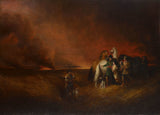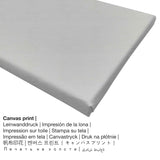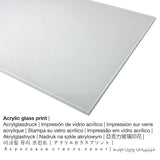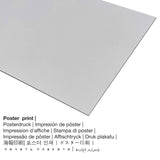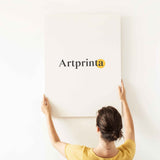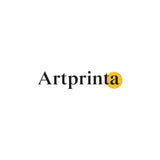Alvan Fisher, 1827 - The Prairie on Fire - fine art print
Tax included. Shipping calculated at checkout.
Summarization of the replica
This over 190 year old work of art named The Prairie on Fire was created by Alvan Fisher. The version of the piece of art has the size: 61 × 83,8 cm (24 × 33 in). Oil on canvas was applied by the artist as the technique for the piece of art. The original artwork is inscribed with the information: signed, dated, and inscribed on verso, prior to lining: Painted by Alvan Fisher 1827. Nowadays, the work of art is in the the digital collection of Art Institute Chicago, which is one of the world’s great art museums, housing a collection that spans centuries and the globe. We are happy to mention that the artwork, which belongs to the public domain is being supplied with courtesy of Art Institute Chicago. The creditline of the artpiece is the following: Through prior acquisition of the George F. Harding Fund; restricted gift of Jamee J. and Marshall Field; Americana Endowment Fund. In addition to this, the alignment is landscape with a side ratio of 1.4 : 1, which means that the length is 40% longer than the width.
Select your product material
In the product dropdown lists you can choose your prefered material and size. We allow yout to choose among the following variants:
- The poster print (canvas material): The poster print is a UV printed cotton canvas paper with a nice surface texture. The poster is designed for putting the fine art print using a custom-made frame. Please keep in mind, that depending on the absolute size of the poster we add a white margin of approximately 2 - 6cm around the print motif, which facilitates the framing with your custom frame.
- Acrylic glass print: An print on acrylic glass, often denoted as a print on plexiglass, will transform the artwork into marvellous décor. In addition to that, the acrylic glass print forms a viable alternative option to canvas or aluminium dibond fine art replicas. The work of art is manufactured with state-of-the-art UV direct printing technology. It makes vivid, deep colors. Our real glass coating protects your custom art print against light and external influences for decades.
- Aluminium dibond print (metal): Aluminium Dibond prints are metal prints with an impressive effect of depth. A direct Aluminium Dibond Print is the excellent start to fine art replicas on aluminum. For our Direct Print On Aluminum Dibond, we print the artpiece right onto the aluminium surface. The bright parts of the artpiece shimmer with a silk gloss but without glare.
- The canvas print: A canvas print is a printed cotton canvas stretched on a wood frame. Your canvas print of this artwork will give you the unique opportunity of transforming your into a large artwork like you would see in a gallery. A canvas print has the advantage of being relatively low in weight, which means that it is quite simple to hang up your Canvas print without additional wall-mounts. Therefore, a canvas print is suitable for all types of walls.
Important note: We try to describe the art products in as much detail as it is possible and to display them visually in our shop. Although, some colors of the printed materials, as well as the printing may diverge slightly from the image on your monitor. Depending on the screen settings and the condition of the surface, not all color pigments can be printed as realisitcally as the digital version on this website. Given that all art reproductions are processed and printed manually, there might also be minor discrepancies in the motif's exact position and the size.
Item specs
| Article categorization: | art copy |
| Method of reproduction: | digital reproduction |
| Production technique: | UV direct print |
| Provenance: | produced in Germany |
| Type of stock: | on demand production |
| Product usage: | wall art, art reproduction gallery |
| Orientation: | landscape format |
| Side ratio: | length to width 1.4 : 1 |
| Image aspect ratio meaning: | the length is 40% longer than the width |
| Material variants: | canvas print, poster print (canvas paper), acrylic glass print (with real glass coating), metal print (aluminium dibond) |
| Canvas print (canvas on stretcher frame): | 70x50cm - 28x20", 140x100cm - 55x39" |
| Acrylic glass print (with real glass coating) variants: | 70x50cm - 28x20", 140x100cm - 55x39" |
| Poster print (canvas paper) size variants: | 70x50cm - 28x20" |
| Aluminium dibond print (aluminium material) options: | 70x50cm - 28x20", 140x100cm - 55x39" |
| Framing of the art copy: | without frame |
Background information on the unique artwork
| Title of the work of art: | "The Prairie on Fire" |
| Artwork categorization: | painting |
| Art categorization: | modern art |
| Time: | 19th century |
| Created in the year: | 1827 |
| Approximate age of artwork: | 190 years old |
| Artwork original medium: | oil on canvas |
| Size of the original work of art: | 61 × 83,8 cm (24 × 33 in) |
| Signature on artpiece: | signed, dated, and inscribed on verso, prior to lining: Painted by Alvan Fisher 1827 |
| Exhibited in: | Art Institute Chicago |
| Museum location: | Chicago, Illinois, United States of America |
| Website of Museum: | Art Institute Chicago |
| License: | public domain |
| Courtesy of: | Art Institute Chicago |
| Creditline: | Through prior acquisition of the George F. Harding Fund; restricted gift of Jamee J. and Marshall Field; Americana Endowment Fund |
General information on the artist
| Artist: | Alvan Fisher |
| Artist gender: | male |
| Artist nationality: | American |
| Jobs: | painter |
| Country of the artist: | United States |
| Artist category: | modern artist |
| Life span: | 71 years |
| Year of birth: | 1792 |
| Year died: | 1863 |
© Copyright protected | Artprinta (www.artprinta.com)
Original artwork description by Art Institute Chicago (© Copyright - Art Institute Chicago - Art Institute Chicago)
Alvan Fisher was a pioneering American landscapist whose work offered an important precedent for the Hudson River School. This painting depicts a subject from James Fenimore Cooper’s 1827 novel The Prairie, the third of the five Leatherstocking Tales. In this scene, Natty Bumppo, the hero of the series, has created a firebreak to protect the story’s protagonists. As a Romantic-era artist, Fisher preferred such dramatic episodes, which involved striking contrasts between light and dark. Unlike contemporaneous illustrations of the scene, which give little sense of setting, in this version the figures are dwarfed by nature, and the prairie grasses are exquisitely rendered, underscoring the landscape’s beauty as well as its dangers. The work thus suggests the significance of the prairie in Cooper’s text. Perhaps for this reason, the author declared that it was “the only good illustration he had seen from his books.”

